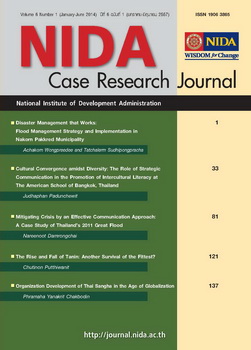Disaster Management that Works: Flood Management Strategy and Implementation in Nakorn Pakkred Municipality
Keywords:
Pakkred Municipality, Disaster Management, Flood, Local AuthoritiesAbstract
In November 2011, the flooded area of Northern Bangkok was a sight to behold. Two of Thailand’s finest universities—one public and one private—were completely under water. No dry ground could be seen within a 50-kilometer radius. Shopping centers, schools, temples, and private residences were severely affected by what soon came to be named, “The Great Flood of 2011.” Earlier, in late October, despite repetitive announcements that everything was under control, the Royal Thai government and the Bangkok Metropolitan Authority (BMA) had f inally issued an executive decree ordering all residents in Bangkok’s northern boroughs to evacuate their communities. Leaving behind their beloved homes and properties, the Northern Bangkokians were housed at government shelters scattered among multiple locations in Thailand’s capital and largest metropolis.
However, Bangkok’s northern neighborhoods were not the only areas affected by this large-scale natural disaster. Many municipalities in Bangkok’s nearby provinces were also badly damaged and, in some areas, the flood level was considerably higher than in Northern Bangkok. Even though flooding had long been a perennial occurrence in the Thai central plains and Bangkok, the Great Flood of 2011 caused damage on an unprecedented and heretofore nearly inconceivable scale in the views of private citizens and government authorities alike.
Yet, amid the chaos and despair, one local community in a province adjacent to inundated Northern Bangkok stood out as a model for natural disaster management. Frequently referred to as the Pakkred Model, the flood management strategy employed by the Nakorn Pakkred municipality attracted attention from the national government agencies, local authorities, mass media, and the public at large. Left largely untouched by the torrent of flood water that had ravaged Thailand’s central plains, Nakorn Pakkred municipality offered a potentially instructive counterpoint to the national government agencies whose ineffectual responses had failed to save Northern Bangkok from turning into an inland freshwater lake. Nakorn Pakkred’s success in shielding itself from the destructive force of the Great Flood was all the more remarkable, given its location. Situated on the muddy shorelines of the mighty Chaopraya River and Bangkok’s waterworks canal, the municipality was particularly vulnerable to flash floods that drained into the Gulf of Thailand. However, out of 30,000 households in the municipality, only 2,000 were inundated. By contrast, neighboring communities were completely, or nearly completely, submerged by the floods.
Equally remarkable was Nakorn Pakkred municipality’s ability to cope with the calamity within the parameters of the limited budget and administrative authority granted municipalities by the central government. That is, notwithstanding the decentralization reform policy adopted by the Thai central government, the administrative prerogatives and budgetary resources remain concentrated in the central government agencies, thus severely hindering the ability of local governments to plan for, and respond to, extraordinary situations such as the Great Flood. However, the administrative and budgetary constraints did not appear to hinder the flood management efforts adopted by the Nakorn Pakkred municipal government. Not only did the municipal government demonstrate its capacity to manage the flood crisis, it also demonstrated that it could do so at economical cost; only 150 million Baht (US$ 5 million) of the public money were spent on the Nakorn Pakkred municipality’s 2011 flood relief efforts.
Thus it was that Nakorn Pakkred and its Pakkred Model of flood management mitigation could be viewed as an object lesson in how to plan for and manage flood crises, despite the disadvantages of limited authority, limited autonomy, and limited budgetary resources. However, to fully appreciate the magnitude of Nakorn Pakkred’s accomplishments, the municipality’s flood-management plans and action had to be juxtaposed against the evolution and current status of local governance policies and practices as these stood at the time of the Great Flood.
Downloads
How to Cite
Wongpreedee, A., & Sudhipongpracha, T. (2014). Disaster Management that Works: Flood Management Strategy and Implementation in Nakorn Pakkred Municipality. NIDA Case Research Journal, 6(1), 1–32. retrieved from https://so04.tci-thaijo.org/index.php/NCRJ/article/view/27696
Issue
Section
Case Study





